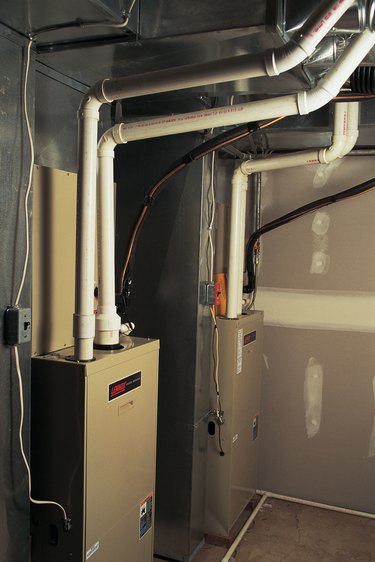
An oil furnace loses its prime when air gets into the fuel lines. Running out of oil is the most common reason why a furnace loses its prime. If you have fuel in the tank but still are encountering problems, check for leaks in the fuel line.
Leaks
Video of the Day
Oil delivery lines are made of copper, steel, brass or iron and may be buried underground or placed on or beneath concrete basement floors. When they come into contact with soil, water or concrete, they can corrode and develop leaks. Delivery lines also may get crushed or broken when there's shifting or settling in the house's foundation. Look for leaks and stains along the fuel line. Protect delivery lines by encasing them in non-metallic protective sleeves.
Video of the Day
Foot Valves
Certain systems are designed to have a foot valve installed at the bottom of the fuel tank so oil won't drain out of the suction lines. If the foot valve is leaking, the oil pump will lose its prime. The location of the foot valve also makes it hard to reach. Instead of using a foot valve, install a check valve just above the tank in a horizontal run to keep the pump and the line in front of the pipe full.
High Routing
Furnaces served by a single line can lose their prime if the storage tank is buried or if the line is routed high beneath the ceiling before it comes back down to the furnace. This is especially common if the tank is low on oil. Oil service technicians recommend using double lines to avoid several problems, including loss of prime.
Bleeding
Air needs to be removed from the fuel line before you can restart your furnace. Use a 3/8-inch wrench or an adjustable crescent wrench. Look for the bleed screw, which usually is located on the left side of the burner. Place a drain pan underneath the bleeder valve. Push the red reset switch once. When the motor turns on, open the screw for a few seconds to let the air out. The oil may look frothy at first. Close the bleeder valve when the pump stops. Your furnace may start at this point; if it doesn't, you may have to reset the burner again to remove the rest of the air. When all of the air is removed, close the bleeder valve and push the reset button.
- InspectAPedia: Guide to Heating Oil Piping Defects & Leaks
- AmeriServe Inc.: Oil Furnace Troubleshooting
- Massachusetts Department of Environmental Protection: Heating Oil Delivery Lines
- Kerns Heating and Air Conditioning: How to Prime an Oil Burner if the Oil Tank Ran Dry
- Wet Head Media: How To Re-Start An Oil Burner After Running Out Of Oil
- Mother Earth News: Oil Furnace Troubleshooting